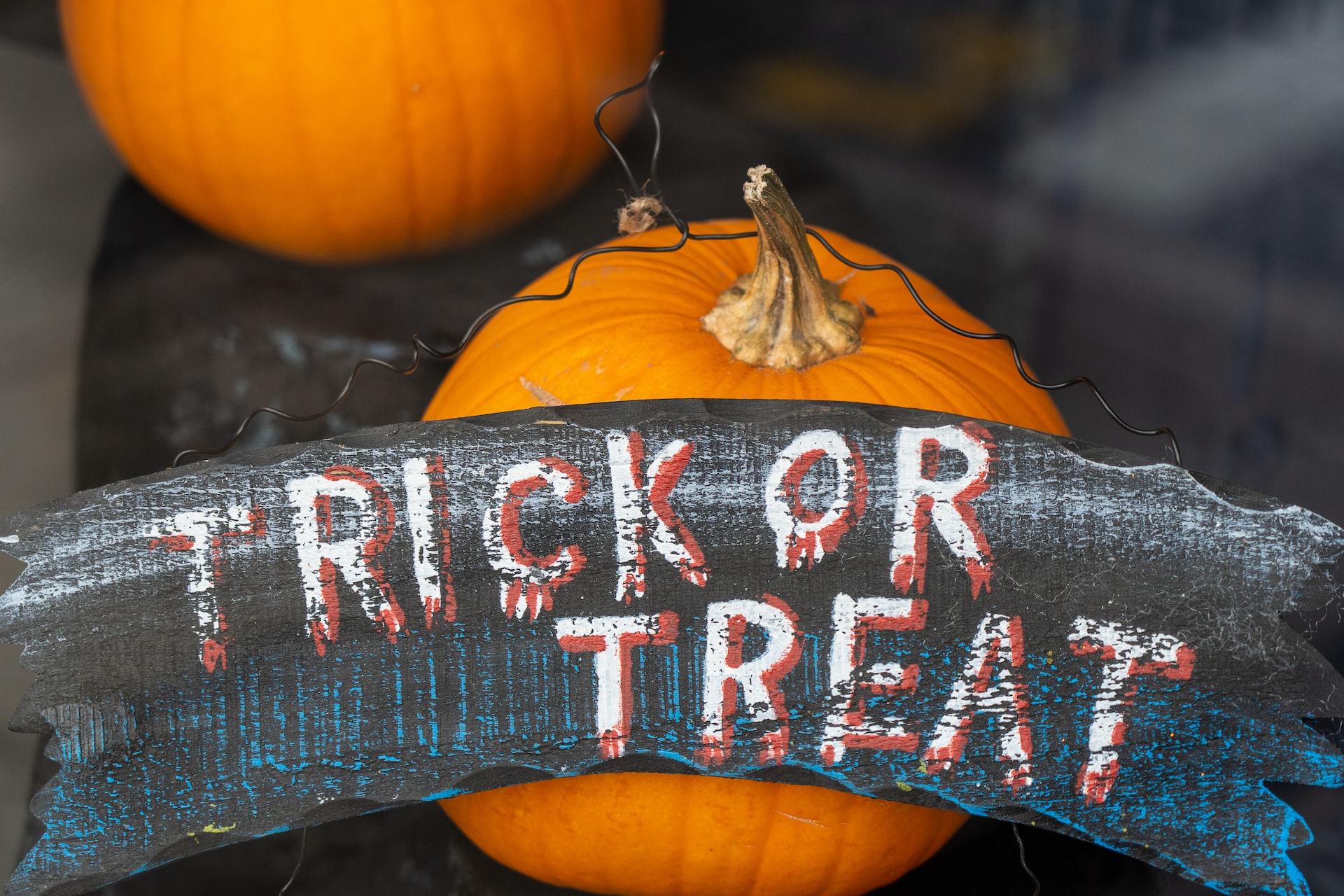What Can Make Halloween Dangerous?
Halloween is one of the most exciting holidays for children and adults alike; dressing up, seeing friends, and indulging in sweets – who wouldn’t want to participate? Along with these fun-filled activities, though, come many different risks that must be considered before the big night, especially for children. From stranger danger to fire hazards, several different factors could endanger Halloween participants. With the focus on fun, these hazards can be forgotten or swept under the rug, but it is important to remain knowledgeable and vigilant surrounding these threats to keep them under control and prevent them from occurring.
In this article, we will discuss the following Halloween safety tips:
1. Keeping Your Decor Fire-Resistant
2. Food Allergies and General Safety Procedures
3. Safety Tips for Trick-or-Treating

Fire Prevention and Halloween Decor
One of the best parts about Halloween is the decorations. Some are spooky, some are funny, and some are more likely than others to be a fire hazard. This is especially true for those who light candles throughout their homes, and even outdoors. Other than the obvious fact that an open flame, no matter the size, has the potential to set fire to the things around it, they are also likely to be forgotten about if they are inside decor or out of reach/direct eyesight. Fire safety is a top priority or Halloween safety tips!
The National Fire Protection Association provides several different tips for preventing injury or damage due to fire this Halloween season:
- Replace tea lights with battery-operated candles for your jack-o-lanterns to completely eliminate the risk of a fire hazard. If you prefer the real thing, however, use only a long, barbecue lighter or long matches to avoid burning yourself/others.
- Keep decorations made with flammable materials away from any fire or heat sources – make sure to check the labels of your decor if you are unsure of its materials.
- Encourage children to choose costumes without long trails of fabric that can be set ablaze within seconds of being too close to an open flame.
- Teach children the importance of fire safety, and staying away from fire sources of any kind, including jack-o-lanterns with lit tea lights inside. Ensure they know the stop, drop, and roll method.
- Of course, and this goes for all year ‘round, ensure your smoke alarms are in good working order.
Food Allergies and Candy-Consumption Safety
Halloween is a great time to let yourself indulge in some sweet and delicious treats; from chocolate to chips to jelly beans, there is something for everyone, and no time like Halloween to try something new! A worry surrounding candy is not so much the sugar content, but the risk of those with allergies consuming something they shouldn’t. On top of this hazard is one that has been at the top of parents’ concern lists every year – tampered Halloween candy. Taking the joy away from families on a night that is supposed to be fun and carefree is an unfortunate evil that this world faces and something we all need to keep an eye out for this Halloween.
Some common allergens that can be found in Halloween candy are: nuts (especially peanuts), milk/dairy products, wheat/gluten, and many more. Adults are usually more aware of what they are consuming – although, there can always be accidents/undisclosed ingredients – but it is especially important that we help out our little ones with allergies, and steer them away from any treats or snacks that could potentially cause them harm. The FDA reminds us to check the labels on any candy before giving it to children with allergies and to teach children not to eat any treat that isn’t commercially wrapped with the ingredients listed. This simple Halloween safety tip could save the life of a child with a serious allergy.
Some great alternatives to trick-or-treating for those children with life-threatening allergies, supplied by The Children’s Hospital of Philadelphia, include:
- Switching the Focus: Make Halloween less about sweets in your home, and put the focus more on things like costumes, decorations, family activities like pumpkin carving, etc.
- Host a Halloween Party: To avoid risking your child feeling isolated or left out of the trick-or-treating fun, host a Halloween party for them and their friends so that they can still join in on the action while you’re monitoring and controlling what they’re consuming.
- Planned-Ahead Trick-or-Treating: Rather than going up and down the streets of your neighborhood, a drive to friends and family’s homes where they are aware of the child’s allergies and can plan the appropriate treats will ensure your child still gets to experience a fun and traditional Halloween night without risking their health and safety.
A lesser-known but very worthy movement that deserves some attention is “The Teal Pumpkin Project”, a simple but effective way to show families with allergies that your home offers non-food treats for them on Halloween night. All you have to do is paint a pumpkin teal or place a sign with one on your yard to indicate you’re participating, and go select your treats/toys for the young ones with allergies!
For further information on tracking food allergens for the safety of those around you, check out Lumiform’s Food Allergy Checklist and use it to guide you through preparing treats for the big night.
As for candy safety in general, there are many small steps that can be taken for huge reasons; The Toronto Star warns us that every year, there are reports of horrible and dangerous attempts of violence against young ones by disguising items like pins, nails, needles, and even razor blades inside children’s Halloween candy. Police everywhere remind and urge parents to check their children’s candy before letting them go through their bags and eating their Halloween earnings. They say that even if a piece of candy looks slightly discolored, or to more obvious signs of tampering like small holes or tears, to retrieve it immediately and contact your local police department for further investigation. These invaluable Halloween safety tips will ensure no child becomes sick or harmed by their candy.

Child-Safety Tips for Halloween Night
There are risks to walking at night that apply to any time of year, not just Halloween, but with so many people and traffic on October 31st, it is especially important that kids know the dangers that come with the territory and remember that safety should be their number one priority. Teach your kids the following Halloween safety tips, especially if you will not be accompanying them on Halloween night, as provided by healthychildren.org:
- Encourage children to select costumes that are bright and/or reflective to minimize the risk of injury to them in the darkness. An added touch would be reflective tape on their costume or bag for extra protection.
- Ensure their shoes are the proper size and comfortable, and that their costumes do not drag under the feet to avoid tripping.
- Avoid any weapon-like props or anything with sharp edges to avoid injury if the child were to fall on it.
- Do not use contact lenses in the children’s eyes without seeing a specialist – they have been known to cause damage in the past, and are usually for adult-wear.
- If the child is wearing a hat, make sure it fits and does not slip down over the eyes and impede vision.
- Provide children with flashlights so they can see their surroundings.
- Walkie-talkies are a great way to communicate if the children are at that age where they want to be independent but you still want to know their whereabouts.
- Only approach homes with a porch-light on.
- Never steer off of the sidewalk.
- Only stay on well-lit streets – do not go down alleys or dark paths.
Be sure you and your child are on the same page regarding safety rules, and go over them together before the big night so that they can focus on having fun and enjoying the spooky festivities.


